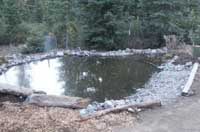(click on thumbnail images to see a larger sized image.
Use your back button to return to the main page.)
We are building our retirement home near McCloud on the sides of Mt. Shasta in northern California.
And, we can't imagine a home without a pond!
At first there was just a big pile of dirt left over from construction with construction
materials left on it.
September 2003.
(click on thumbnail images to see a larger sized image.
Use your back button to return to the main page.)
We cleaned off the area and when we had the pile of dirt pushed back up next to the
home, we also had a hole dug for the pond.
Doing it with the bulldozer was soooo much easier than with
a shovel!
This first image shows how big the hole was when I asked him to start it, but I kept saying "Bigger!"
And "Bigger!"
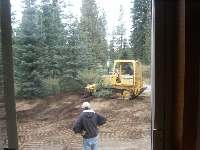
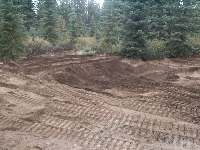 October 2005
October 2005
We let the new hole sit for a year to settle in, but we did do some shaping,
creating a bog area to the right and planting shelves along the back edge.
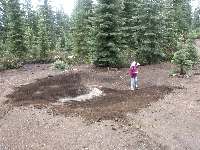 Late May 2006
Late May 2006
In preparation for putting the liner in, we made certain that the edges were level.
 Early September 2006
Early September 2006
Finally, in late September of 2006, we put in an underlayment of old (used) carpeting.
This protects the pond liner from sharp objects and chipmunk/gopher bites!
Late September 2006 - first day
Next we took the liner out of the trailer we'd used to bring it up north, and spread it out.
first day
Next, we started filling it up, but it was already getting dark (We didn't arrive uptil ~5 pm so got a late start!).
first day
On the 2nd day we continued to fill the pond and I carefully set some underwater plants,
Elodia canadensis, on the pond bottom as the pond filled.
The Elodia's purpose is to use up any nutrient that is in the water, thus starving any algae blooms; therefore the plants
aren't potted in any soil.
They are just placed on a tray with rocks weighing them down.
second day
We are totally off the grid up there and use 2 solar
collectors to provide the energy to pump our water into a 2500 gallon storage tank.
We used several lengths of hose connected together to run from the bottom of the tank to the pond - gravity fed.
This bypassed the home's pressure tank.
It's important to be able to get in and out of your pond for maintenance (or cooling fun!).
A pond liner can get quite slippery, esp. since pond bottoms are usually sloping,
and over time get covered with a slime coat
(not a bad thing, except for walking on!).
So, it is important to provide a safe way to enter (and exit) your pond.
If you have firm soil, you can dig steps before you line the pond.
Our soil is sandy (volcanic ash!) so to provide steps,
I filled bags with soil and placed them between the carpet layer and the liner.
second day
I also wanted to provide a 'beach' - this is very important in a wildlife pond,
but I wouldn't want the beach materials (probably small river rock) slipping into the deep end.
So I also put a barrier between the carpet and the liner. I used 'swim noodles' - very inexpensive!
That's as far as the pond filled that 2nd day.
Another important feature of a wildlife pond is to provide an 'escape route' for any creature that falls
into the pond.
A good way to provide this is to have some feature that is part way in, and part way out, of the pond.
I used a dead manzanita bush skeleton - we have many on our property.
third day
Right away the birds adopted it as a perch to land on for drinks and a bath (the liner was too slippery and foreign to them).
But within 24 hrs it had already been used as an escape path - by a western fence lizard!
By the 3rd day, the pond was already full of aquatic insects!
As we watched a concentric ring would appear, and below it we'd see a backswimmer swimming down into the pond.
We also saw both large and small diving beetles.
And my favorites, the dragonflies had made an appearance:
a large darner, possibly a hot and thirsty migrant, dipped its legs into the pond,
and some species of Bluet Damselfly amazed us by flying back and forth across the pond once before disappearing.
I think the damselfly was disappointed in not finding any emergent vegetation - come back next year!
This is a very arid region and the nearest water is over a mile away. It's amazing that so many creatures found us right away !
On the last day before we left, I did something that you might not need to do:
I started putting in an edging of bricks for stability.
I'm placing these interlocking bricks by burying them in our sandy soil.
The idea is that they will form a firm and level underlayment for the rocks and other edge treatments I'll be adding later.
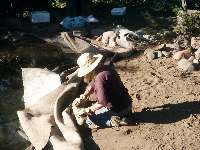 fourth day
fourth day
We weren't able to finish filling the pond as our water tank was just about empty.
Here's how the pond looked just before we left.
fourth day
Here's a list of the pond's critters that we noticed these first few days of its existance:
Birds: Mammals 1.White-crowned Sparrow 1.Least Chipmunk 2.Fox Sparrow (MANY!) 2.Yellow-pine Chipmunk 3.Mountain Chickadee 3.California Ground Squirrel 4.American Goldfinch 4.Douglas Squirrel 5.Golden-crowned Sparrow Insects 6.White-headed Woodpecker (pair) 1.Darner Dragonfly 7.Stellar's Jay 2.Bluet Damselfly 8.Audubon's Warbler 3.Backswimmers (a hundred or so!) 9.Dark-eyed Junco 4.Diving Beetles 10.Cassin's Finch 5.Yellow Jackets 11.Spotted Towhee 6.Water Striders
Links to pictures we've taken of these critters and others that have visited our McCloud pond can found at this link: Shasta Critters
We hoped to be back up to finish the edging and filling soon.....
...and we were. Click on the image below to see our progress:
